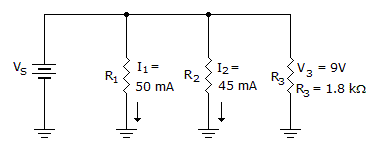Discussion
Home ‣ Electronics ‣ Parallel Circuits Comments
- Question
The voltage across any branch of a parallel circuit:
Options- A. varies as the total current varies
- B. is inversely proportional to total circuit resistance
- C. is equally applied to all branch conductances
- D. is dropped in proportion to each branch resistance
- Correct Answer
- is equally applied to all branch conductances
- 1.

What does VS equal in the given circuit?
Options- A. 0 V
- B. 9 V
- C. 27 V
- D. More information is needed to find VS. Discuss
- 2. Kirchhoff's current law for parallel circuits states that the:
Options- A. sum of all branch voltages equals zero
- B. total circuit resistance is less than the smallest branch resistor
- C. sum of currents into a junction is equal to the difference of all the branch currents
- D. sum of the total currents flowing out of a junction equals the sum of the total currents flowing into that junction Discuss
- 3. What is RT for fifteen 2 MΩ resistors all connected in parallel?
Options- A. 133 kΩ
- B. 300 kΩ
- C. 750 kΩ
- D. 30 MΩ Discuss
- 4. If a 1 kΩ and a 2 kΩ resistor are parallel-connected across a 12 V supply, how much current is received by the 2 kΩ resistor?
Options- A. 4 mA
- B. 6 mA
- C. 8 mA
- D. 12 mA Discuss
- 5. What is the total resistance?

Options- A. 7 kΩ
- B. 1 kΩ
- C. 706 Ω
- D. 353 Ω Discuss
- 6. What are the individual values of two parallel resistors whose RT is 8 ohms, when one has double the resistance of the other?
Options- A. 2.7 ohms and 5.3 ohms
- B. 8 ohms and 16 ohms
- C. 10 ohms and 20 ohms
- D. 12 ohms and 24 ohms Discuss
- 7. Which is considered to be the common reference for a parallel circuit?
Options- A. Voltage
- B. Current
- C. Power
- D. Resistance Discuss
- 8. When parallel resistors are of three different values, which has the greatest power loss?
Options- A. The smallest resistance
- B. The largest resistance
- C. They have the same power loss.
- D. Voltage and resistance values are needed. Discuss
- 9. Which are the better test devices used to isolate a suspected open component within a parallel circuit?
Options- A. a voltmeter or an ohmmeter
- B. neither an ammeter nor a voltmeter
- C. a wattmeter or a voltmeter
- D. an ammeter or an ohmmeter Discuss
- 10. Components that connect in parallel form:
Options- A. branches
- B. open circuits
- C. short circuits
- D. a voltage divider Discuss
Parallel Circuits problems
Search Results
Correct Answer: 9 V
Correct Answer: sum of the total currents flowing out of a junction equals the sum of the total currents flowing into that junction
Correct Answer: 133 kΩ
Correct Answer: 6 mA
Correct Answer: 353 Ω
Correct Answer: 12 ohms and 24 ohms
Correct Answer: Voltage
Correct Answer: The smallest resistance
Correct Answer: an ammeter or an ohmmeter
Correct Answer: branches
Comments
There are no comments.More in Electronics:
Programming
Copyright ©CuriousTab. All rights reserved.
